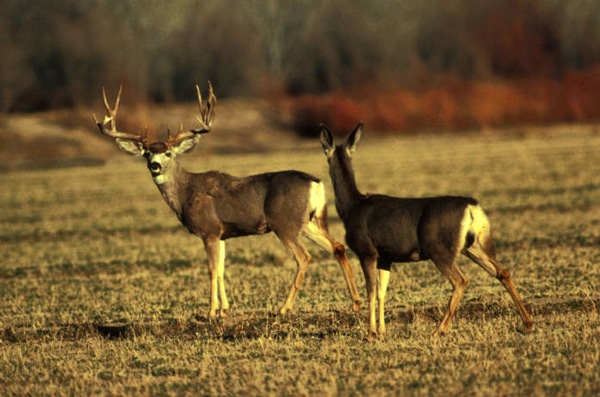
Texas Parks and Wildlife Commissioners approved a new federal rule this week that outlines changes in animal health regulations that will affect protocols for handling and testing for chronic wasting disease (CWD) in the Texas cervid population. The new rule will be published in the next issue of the Texas Register and allows for a 20-day period for public comment before the rule takes affect.
State wildlife and animal health officials say the new rule is “timely” after Texas experienced its first case of CWD in June this year when two male mule deer near the New Mexico border in Far West Texas tested positive for the disease.
CWD is a fatal neurodegenerative disorder that affects cervid species such as white-tailed deer, mule deer, elk, and others susceptible species. It is classified as a transmissible spongiform encephalopathy, a family of diseases that includes scrapie (found in sheep) and Bovine Spongiform Encephalopathy (BSE, found in cattle and commonly known as Mad Cow Disease).
TPWD closed the Texas border in 2005 to the entry of out-of-state captive white-tailed and mule deer over fears of CWD and has increased regulatory requirements regarding disease monitoring and recordkeeping. Since 2002, the department has tested more than 26,500 wild deer in Texas for CWD, and cervid producers have submitted more than 7,400 test results to the department.
The new rule represents the second attempt by TPWD to put the issue before the public. The first set of proposed rules was withdrawn by Commissioners when additional study indicated parts of the proposed rules required amendments. The new federal rules address not only monitoring and movement of cervid populations in the wild but also those at breeding facilities across the state.
Karl Kinsel, a Texas breeder and livestock producer, serves as executive director for the Texas Deer Association (TDA), the non-profit group that has long advocated cervid health issues and serves as a trade association for member breeders across the state. Along with a group of individual ranch owners and state officials, Kinsel served on the Cervid Health Working Group in reviewing and discussing TAHC’s monitored herd program, proposed intrastate and interstate movement rules, surveillance programs and monitoring efforts of wild and farm-raised deer.
Kinsel says TDA members were interested in how current industry practices and regulations compared to the proposed new rules.
“The hearing in Austin went rather well as far as (the) information we had to work with. We discussed how the rules would establish containment areas as needed and talked about the movement of deer. We reviewed the state’s proposed emergency response plan when chronic wasting disease is discovered,” Kinsel said.
“We are fortunate to have good people over at Parks and Wildlife and at the Texas Animal Health Commission. Many states have overreacted to the threat and we wanted to make certain we took a scientific approach to the problem and separated the facts from the myths when it comes to CWD.”
Kinsel says the TDA was formed in part to help members deal with animal health issues and to make certain breeders are using the best methods possible to ensure the best pen-to- pasture practices.
Breeder participation
Most of the 1,000-plus Texas breeders participate in two programs related to CWD. The first is a TPWD testing program initiated in 2002 that requires all cervid breeders in the state to test at least 20 percent of animal deaths each year, a procedure that must be paid by the breeder. Secondly, most breeders in the state voluntarily participate in a Texas Animal Health Commission (TAHC) CWD Monitored Herd program, which requires testing of 100 percent of all eligible deaths each year.
Out of approximately 848,706 free-ranging (non-breeder) cervids tested across the nation since 1998, approximately 3,600 free-ranging cervids were found to be CWD positive. TPWD reports that from 2002 through 2010, a total of 33,900 breeder and wild cervids have been tested for CWD, but CWD has never been found in Texas in white-tailed deer, a number that TDA members say speaks well to the commitment of Texas breeders to prevent the spread of the disease.
Texas breeders say selecting the right rules is important for the viability of the breeding industry. For example, attempts to eradicate CWD in other states, such as Wisconsin, have proven generally ineffective and have had disastrous effects on local economies dependent on goods and services related to hunting.
Kinsel says Texas deer breeders support monitoring and testing programs designed to limit the movement of animal diseases among free-range wildlife and breeding stock at hundreds of facilities across the state.
“One of our primary goals is to make certain we keep Texas a top destination for hunters. It’s an $8 billion industry that adds a great deal to our economy, and the efforts of the TDA are designed not only to protect the animals we breed but (also) to manage them properly, and this includes good animal health practices,” he adds.
Kinsel says the state’s cervid breeding industry adds another $700 million to the state’s economy, according to a Texas A&M study, and that adopting rules that are based on science is the best way to ensure the industry remains a viable alternative for rural property owners who often supplement their agriculture operations with breeding programs.
Once published in the Texas Register, the public will have 20-days to submit comments before the rule takes affect.
About the Author(s)
You May Also Like




